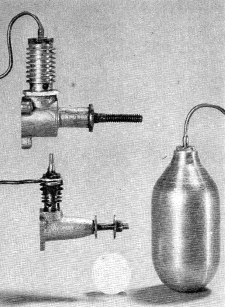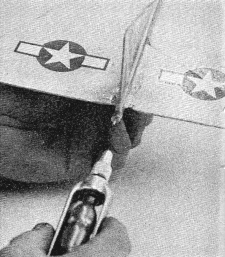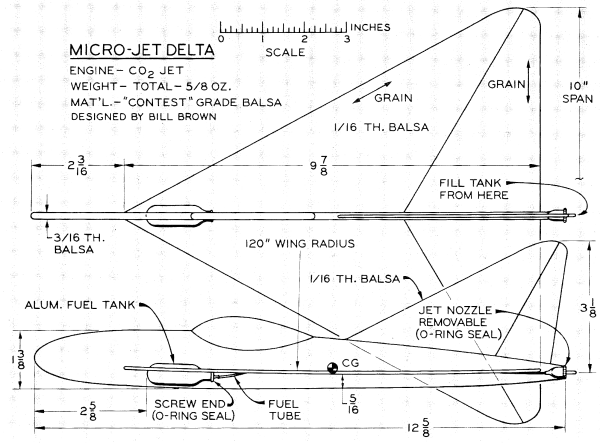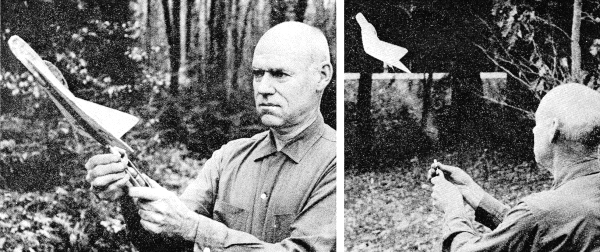|
[borders/_archive/sub-header.htm]
If the authors of
this article had a crystal ball to see into the future, they would have been disappointed
to learn that their prediction for a resurgence of CO2-powered model
aircraft was not going to come true. Today it is difficult to get a CO2
engine other than to buy a used one on eBay.
See the "Fizz-Wizz"
article from the March 1962 American Modeler and the "Push-Air
CO2-Powered Free-Flight" article from the February 1970 American
Aircraft Modeler. Here are my DP-03CO2
motor and my Herkimer OK CO2 motor.
CO2 Power is Coming Back
Return of once popular CO2 flying brings improved and lighter engines and all-new
compressed-gas jet- here used on the Micro-Jet Delta.
Howard Mc Entee and Bill Brown Jr.

This is an old 005 engine modified by McEntee for convenient
top-of-cylinder refilling. New engine not yet in production.
OLD-TIMERS who remember the late 1940's will recall the interest in CO2-powered
(CO2 in this article means carbon dioxide) model planes, for sport flying and competition
(there was at least one AMA class). These remarkable powerplants were developed
by Bill Brown Jr., already famed for the development of the Brown Junior gas engine
(that's gas, not glow!) which revolutionized model aviation, and brought on the
continuing development of tiny model glow engines which have reached such perfection
today.
Never one to rest on his laurels, Bill then dabbled with CO2 power. In the post-war
1940's he perfected three sizes of these engines. One was a rather large job (relative
to his others), which turned an 8" prop with lots of power. It used an entire Sparklet
CO2 cartridge for each flight. These cartridges were used then, as they are now,
for specially equipped bottles that turned plain tap water into "soda water" for
drink mixing. This engine had a displacement of .018 cu. in. Really interested in
much smaller units, Bill sold all rights to the big engine to Herkimer Tool &
Model Works, who marketed the engine under their "OK" label as late as the early
'60's.

Larger engine, an 018 Herkimer OK, is shown with the 005 mill
and its light-weight aluminum supply tank. Note aspirin tablet!
Next came Bill's favorite - the tiny A-100. The complete powerplant, less prop,
weighed about ¼ oz. A low-pitch 4"-dia. prop was recommended. It flew planes ranging
from 1-2 feet span, which weighed about 1½ oz. maximum. It was flown very successfully
in tiny all-balsa scale planes of 12" or so. The displacement was only .0015 cu.
in.! The final engine in the series was the "B," with a displacement of .005 cu.
in. and total plant weight (including tank but less prop) of about .65 oz., for
planes up to 30" span. Production on both of the smaller engines ceased around 1950.
Those of us who were active with CO2 had a high regard for Bill Brown's developments,
but we (and Bill, too) freely conceded that some detail improvements were needed.
Tank filling was a bit unhandy. You screwed the cartridge holder into a valve in
the tank, a simple but fussy operation. The A-I00 crankshaft bearings wore rapidly.
Some of us put in brass bushings - but this thinned the crankcase nose so that it
broke easily. Basically, the plants worked fine, and the incentive for improvement
came when the late Jim Walker became interested in them.
With such backing, Brown developed a much simpler, faster and more convenient
filling system. The tank is fueled through a tiny nipple on the engine cylinder
head. Crankshaft bearings were greatly improved and the case beefed up considerably.
A much better valve material was found for the engine. CO2 gas is admitted to the
cylinder through a tiny ball valve. Great things were looked for with the improved
design but Jim's death brought a halt to CO2 progress.
Over the years, Bill Brown Jr. has run his machine-tool business in central Pennsylvania
for a living- but continued to dream of marketing better CO2 powerplant. We're happy
to report that such marketing may not be too far off. Bill has refined designs for
three engines, with .001, .005 and .02 cu. in. displacement.

Jet is easily filled through outlet nozzle using CO2 cartridge
and holder - which has pressure fitting. This fitting also is the launch-release
device. Thrust nozzle adjustable for power output and duration. Delta is exciting
fun job. Jet can be mounted in dime-store, 29c gliders.
There is also a tiny jet engine. Due to its relative simplicity, it doubtless
will be marketed first. However, all components of this plant will be worked into
the piston powerplant to come later. We show here with a little delta profile jet
plane Bill has been flying. Thrust doesn't last long-about 5 seconds (replaceable
nozzles with different-sized orifices will be offered for varying thrust)-but the
plane gets high enough for a fine glide.
Brown has chosen the middle-sized .005 engine as his first piston job of the
new series to be marketed, but its difference from the old "B" is amazing. About
the only similarity is the .005 cu. in. displacement. The plant will weigh little
more than the old A-100, and the engine itself isn't much bigger than the A-100
engine (which was only about 7/8" from top to bottom) . This engine will be marketed
with the same tank used for the jet engine (larger or smaller tanks may be used,
however). The jet engine itself (with proper nozzle to act as a filler valve) may
be employed to "gas up" the piston plant, if you want to bury the engine in an inaccessible
spot - inside a scale plane cowling, for example.
While the .005 and .02 engines offer ample power to fly outdoor F IF models of
all types, the .001 job sounds ideal for the tiniest indoor designs! All the engines
can be adjusted easily for thrust. Thus, the .005 should do fine indoors. Furthermore,
with the very tiny and light gear we have today - it sounds like a natural for indoor
R/C flying. Just think of the possibilities: No smoke, no smell, very little noise,
no fire hazard, instant starting every time, low fuel cost (we used to get up to
six flights from a single Sparklet cartridge). Larger cartridges that are refillable
reduce even this cost, allow many dozens of flights before refilling. You can even
recharge these larger cartridges yourself, from the CO2 fire extinguishers and tire
inflators sold in some garages (and these too are rechargeable for a nominal fee).
We wish to emphasize that these CO2 power units are not on the market yet - so
don't write and. ask where you can get them. We don't know where - or exactly when.
But it appears that Bill Brown Jr.'s long wait to market perfected tiny CO2 powerplants
is about to end. You can be sure we'll keep you posted as to when he has something
ready to sell. It shouldn't be long now!

Micro-Jet Delta: Full-sized plans for this tiny speedster aren't necessary. Just
use the dimensions noted on our reduced plan. Be sure to use the lightest 3"-wide
Contest balsa throughout. You can fudge a tiny bit when laying out the wing, even
though when scaled to full-size, our plans show that 3½" wide sheet is required
for the rear portion of the wing. Cement the three sections of wing sheet together
first on a flat surface, then slip the sanded assembly into the fuselage slot and
cement firmly. Note there is a slight curvature in the wing; the center (at about
the CG point) is 1/8" lower than the leading and trailing edges. Bill just drew
a radius for a very large circle for the wing section. You can probably eyeball
this. The exact curve isn't vital, just as long as there is 3/32" to 1/8" difference,
as noted.

The tank must be cemented firmly in place. Feed tube to the jet engine is shown
going into the fuselage slot, but could just as well be under the wing. It is vital
to have the jet nozzle pointed correctly. This might require adjustment. The jet
unit must be cemented to the fuselage firmly, since the entire plane is supported
by the jet nozzle, when you are charging the tank.
The "Load-N-Launch" filler holds the CO2 cartridge, and has what appears to be
a small knurled "chuck" at the forward end. The knurled portion is turned until
the filler is a snug, but not tight, fit on the jet nozzle. Once this adjustment
is made, you will not have to repeat it. The filler can be slipped on and off the
nozzle with light pressure.
The special filler for the jet engine has a further sliding tip that fits over
the chuck end. After you have charged the tank in the plane, you point the whole
works up at a moderate angle, holding the filler with one hand, the sliding tip
piece with the other. The plane is supported entirely by the jet nozzle fit in the
filler chuck. Now push the sliding tip piece smartly forward. This disengages the
jet nozzle from the filler chuck, and gives the little jet a launching shove, whereupon
the CO2 takes over to provide rapid acceleration.
No finish is needed on the plane. Remember, there is no oil or dirty fuel involved.
Keep it light for the best results. Note that as this is written we do not have
information on exactly when the jet units will be marketed, or what the price will
be. But when they reach the hobby shops, you can be all ready to fly one with this
simple delta. Bill Brown has found it to be a fine flier, and you should too!
Articles About Engines and Motors for Model Airplanes, Boats, and Cars:
Posted July 20, 2013
|




